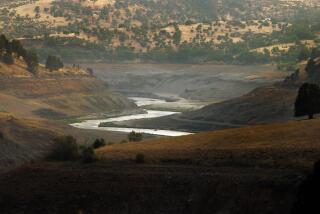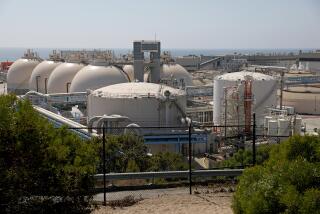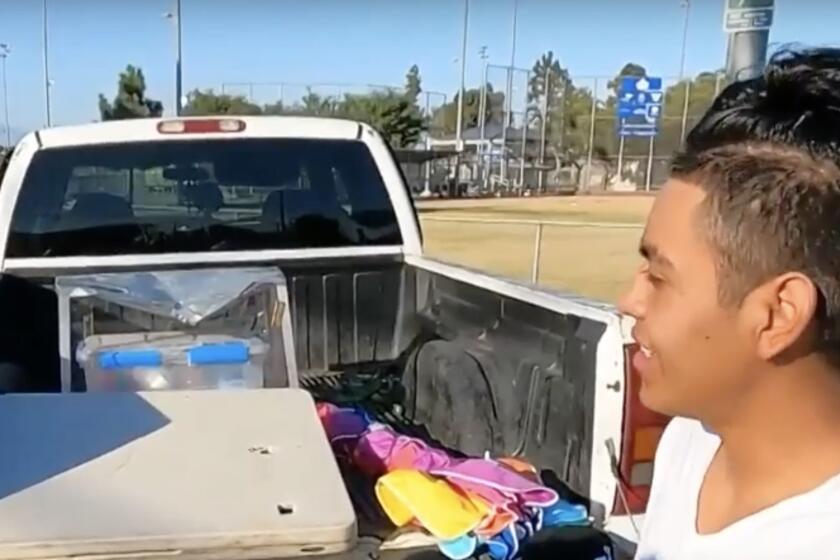L.A., conservationists reach agreement to repair Mono Lake damage
Ending decades of bitter disputes over fragile Mono Lake, Los Angeles and conservationists on Friday announced an agreement to heal the environmental damage caused by diverting the lake’s eastern Sierra tributary streams into the city’s World War II-era aqueduct.
The controversy over alkaline Mono Lake, which is famous for its bizarre, craggy tufa formations and breeding grounds for sea gulls and migratory birds, is one of California’s longest-running environmental disputes.
The settlement resolves all of the issues among weary combatants, including the city of Los Angeles, the Los Angeles Department of Water and Power, the California Department of Fish and Wildlife, California Trout and the Mono Lake Committee.
It calls for construction of a $15-million adjustable gate in Grant Dam, an earthen structure 87 feet high and 700 feet long designed to impound tributary water. The goal is to release pulses of water along a seven-mile stretch of Rush Creek to mimic annual flood cycles, distributing willow seeds and promoting healthy trout populations. The settlement will not affect water levels at Mono Lake.
Roughly 12,000 acre-feet of water will be exported to Los Angeles, which will allow DWP ratepayers to make up half the cost of the improvements at Grant Dam.
The DWP Board of Commissioners on Tuesday is scheduled to vote on the settlement, which will improve the utility’s image as it prepares to celebrate the 100th anniversary of the aqueduct that helped transform the city into a metropolis of nearly 4 million people and turned portions of the Owens Valley and Mono Basin into arid wastelands.
DWP general manager Ron Nichols said the agreement “accommodates the concerns of Mono Lake stakeholders in a manner that is respectful of the concerns of LADWP’s water customers for reliable and affordable water while providing certainty for all parties in the future.”
The settlement will not recreate historic flows, “but it will restore fisheries and riparian habitat that existed before the aqueduct was extended into Mono Basin in 1941,” said Geoffrey McQuilkin, executive director of the Mono Lake Committee, a nonprofit group organized to save and protect the bowl-shaped ecosystem roughly half the size of Rhode Island. “Now, the aqueduct can operate as required to protect the ecosystem here even as it delivers water to the city.”
The settlement comes about two decades after the city was ordered to reduce the amount of water it had been diverting from Rush, Lee Vining, Parker and Walker creeks.
“This is a big deal,” said Mark Drew, eastern Sierra regional manager of Cal Trout. “It was incredibly arduous to reach this agreement, which speaks to the commitment of the parties involved.”
The environmental damage in the region just east of Yosemite National Park and about 350 miles north of Los Angeles was apparent by the 1970s. Tributary streams dried up. The lake level had dropped more than 40 vertical feet and the water had doubled in salinity, leaving behind smelly salt flats. The increasingly salty water threatened to kill brine shrimp, a favorite food of the estimated 50,000 California gulls that breed there each year.
The sex life of gulls became a hot topic when a declining water level revealed a land bridge connecting an island rookery to the shore, allowing coyotes to pad across and feast on the birds and their nests.
Formal protests began with a lawsuit filed in Mono County Superior Court in 1979 against the DWP by residents and environmental groups led by the Mono Lake Committee. The lawsuit alleged violations of public trust and creation of a public and private nuisance by the exposing of 14,700 acres of former lake bed.
In 1983, the U.S. Supreme Court let stand a California Supreme Court ruling that environmentalists have the right to challenge the amount of water that Los Angeles imports from tributaries of Mono Lake. A decade later, the California State Water Resources Control Board ordered minimum flows restored for the diverted streams and set a minimum water level for Mono Lake while still allowing the utility to divert some water for consumption in Los Angeles.
The city’s other major source of water in the region — the Owens River and a battalion of wells pumping aquifers beneath the Owens Valley — is unaffected by the Mono Lake agreement.
New stream-flow regimens are already underway, and structural modifications at Grant Dam could be completed within four years.
“We’re expecting a huge leap forward in the recovery of an estimated 19 miles of stream corridors affected by this agreement,” McQuilkin said. “We expect to see stream-side forests, more insects, birds and animals — and more and bigger fish.”
More to Read
Sign up for Essential California
The most important California stories and recommendations in your inbox every morning.
You may occasionally receive promotional content from the Los Angeles Times.











